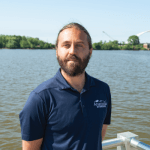Cheyenne Holliday
Portland, Oregon
This interview was conducted by Carly Schmidt on February 8, 2022. Learn more about Cheyenne’s work at https://www.verdenw.org/.
Transcript
Tell me about your role at Verde and what you’re focused on now?
I am the water justice coordinator at Verde. I do anything water related across the state, while also doing a little bit of federal policy work. About one third of my time is spent focusing on policy work and making sure that I’m up to date and ready to answer any questions. Another third is answering emails and attacking anything that could be water related in the state of Oregon. The last third of my time is spent working with the Oregon Water Futures Collaborative.
What is the Oregon Water Futures Collaborative?
The Oregon Water Futures Collaborative includes Verde, Coalition of Communities of Color, University of Oregon Indigenous, Race, and Ethnic Studies Department, Oregon Environmental Council, and Willamette Partnership. We focus on water and leadership in the state of Oregon for low-income, rural, communities of color and Indigenous communities. We created the Oregon Water Futures Project Report, where we co-conceptualized and facilitated a conversation with Native, Latinx, Black, and various migrant communities across the state. We have conversations around culturally-specific ways different individuals in Oregon interact with water, including drinking water and bodies of water quality of water and cost, and how they use resiliency in the face of challenges of accessing water resources. We explored different levels of community engagement involving 6 different languages.
The report was published in 2021 and we made recommendations for the Oregon Legislature that resulted in $500 million being re-invested into low-income, rural, Black and brown communities. We are now in the process of using that information to create an Oregon-specific water justice framework that will help to advance policy and develop a Water Justice Leadership Institute. We are in the community engagement and curriculum building phases of that plan.
What are the desired outcomes of the Water Justice Leadership Institute?
One objective is awareness around water justice issues at every level, including state media support, while also focusing on the household and individual level. The second objective is to develop community capacity and leadership skills for water justice and really put the power into our neighbors’ hands. We would also like to identify projects across the state and opportunities for local action. Ideally, we will have 15 to 20 residents participate from all over Oregon who will learn about the water issues facing their communities but also build the skills for them to become advocates for themselves.
Why did the Oregon Water Futures Collaborative form and what were the objectives behind this large-scale partnership?
We have a changing climate and aging infrastructure across the state. There is a lot of ongoing investment that only benefits some and leaves many people out of the conversation. In recognition of the challenges facing our water resources, the idea started to form. The state of Oregon decided to create a 100-year water plan. That plan has been delayed because of COVID and is still rolling out on an ongoing basis. Our project partners realized that there would be people left out of the conversation and thought that we could be the ones to do this work and include people directly in a way that would impact the investment plan and the policy changes that follow.
We really wanted to use storytelling to uplift these individuals and communities, which isn’t always used when people are looking at data. We also wanted to use our existing relationships and power to help individuals create their own impact on policy. That’s how it started. We wrote and published the report and I don’t think any of us were expecting it to have the impact that it had, especially within the Oregon Legislature. One of our next steps was the Water Justice Leadership Institute and, after we released the report, we realized that we could get started on that project right away. We’re hoping to launch in March 2023.
You are being really intentional about building the foundation for the Water Justice Leadership Institute before the launch next year. How are you preparing for the program?
Our core goal of the Institute is to lift up voices across the state around water and environmental justice issues. Also, we’ll work to identify and elevate community priorities with the lens of culturally specific resiliency and like one of the things we learned is that there is so much knowledge that isn’t shared or known because it doesn’t use the traditional environmental justice language. But the information is there and it’s so rich. Instead of going into these conversations with an agenda we wanted to hear what the community wanted to talk about. It takes time to listen to everybody, to make sure everything is translated, to ensure that adequate funding is allocated, and ensure that we’re doing more good than harm.
Was there a specific finding from this research that surprised you?
We went in with a few topics to discuss, while also leaving room for emergent topics. We discussed water in your home, water quality, local rivers, children’s play areas, and infrastructure. One of the community-driven topics that emerged was emergency preparedness. This was probably because some of these conversations were around the Oregon wildfires and the social uprisings that were happening across the country. We learned a lot about the value of simply providing translation for emergency alerts. We were surprised that many communities weren’t getting essential information through the traditional channels, but through calls from family and friends. This called into question water affordability and how this could also be considered an emergency. These conversations led us to the idea of the people side of water infrastructure.
What would it look like to approach emergency preparedness in a way that ensures that all communities in an area have equal access to essential information and services?
I don’t know the exact answer, but I think it’s about creating long-term trust between communities and governments. In the report, we found that people don’t always trust their government or their county, but they do tend to trust community-based organizations. Maybe there is something there in terms of who is distributing essential information and using the state to assist in the distribution of information rather than controlling the distribution. There isn’t a one size fits all approach, and we learned that from our research. This kind of engagement takes time to build trusting relationships. It doesn’t happen without flexibility, adaptability and creative engagement.
What is next for this report and how do you think it will impact state policy going forward?
We’re working with communities across the state to build an Oregon water justice network. We have started that process and we’re actually having our first network call today at noon. Through our community engagement, we’re hoping that the Oregon Water Justice Framework will bring people together again to provide their input on local and state policy. We are also building a curriculum for the Water Justice Leadership Institute to build community water leaders. This is something that’s never been done before in the state of Oregon and we’re looking forward to bringing local leaders together to advocate for their communities.
About
Cheyenne Holliday is a born and raised Oregonian who grew up on a small farm outside of Portland where her family rescues and rehabilitates horses. She has a background in Conflict and Dispute Resolution and has worked as a conflict resolution specialist, facilitator, and mediator. At Verde, she works as the Water Justice Coordinator and will focus on economic, environmental, and racial justice issues around water at both the statewide and national level. In 2020 Cheyenne collaborated on and co-authored the Oregon Water Futures Report which facilitated a series of conversations with Native, Latinx, Black, and various migrant communities across the state. In her spare time she also coaches competitive cheerleading to Oregon and Washington youth.







